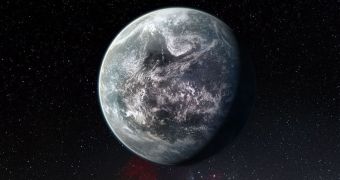The number of confirmed extrasolar planets just got bigger, thanks to a sustained effort by experts operating the European Southern Observatory's (ESO) High Accuracy Radial Velocity Planet Searcher (HARPS). In their latest study, the astronomers found no less than 50 new exoplanets.
One of the most interesting results the team arrived at during this investigation is that more than 40 percent of all Sun-like stars in the Universe appear to have at least one planet with a mass lower than Saturn's orbiting them.
This is a monumental discovery, since it hints at the fact that rocky, Earth-like exoplanets may not be as rare as once thought. Granted, large-scale cosmic surveys will need to be conducted in order to confirm this correlation, but astronomers are confident their new results will hold.
Of the 50 new exoplanets, 16 are part of the super-Earth class, meaning that their size and mass are larger than our planet's, while remaining smaller than a gas giant. Interestingly, several of the newly-discovered ones appear to lie at the outskirts of their parent star's habitable zones.
These are the areas of any star system where temperatures are just right to support the existence of liquid water. Earth lies smack in the middle of the Sun's habitable zone, while Mars and Venus orbit at the fringes on either side.
One super-Earth in particular is of special interest to astronomers, since it was determined to orbit right on the edge of its star's habitable zone, just like Mars does. The object was analyzed using the HARPS spectrograph on the 3.6-meter telescope at the ESO La Silla Observatory, in Chile.
Details of the new study were presented at conference on Extreme Solar Systems, which is still being held in Wyoming, the US. More than 350 extrasolar planet experts are coming together to discuss issues pertaining to this expanding field of research.
“The harvest of discoveries from HARPS has exceeded all expectations and includes an exceptionally rich population of super-Earths and Neptune-type planets hosted by stars very similar to our Sun,” says astronomer M. Mayor, from the Observatoire de Genève (OAUG), in Switzerland).
“And even better – the new results show that the pace of discovery is accelerating,” adds the scientist, who was also the leader of the new investigation. The study will be published in an upcoming issue of the esteemed scientific journal Astronomy & Astrophysics.
“These planets will be among the best targets for future space telescopes to look for signs of life in the planet’s atmosphere by looking for chemical signatures such as evidence of oxygen,” study expert Francesco Pepe, of the Geneva Observatory in Switzerland, concludes.

 14 DAY TRIAL //
14 DAY TRIAL //